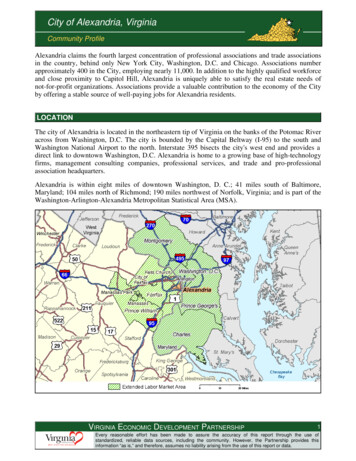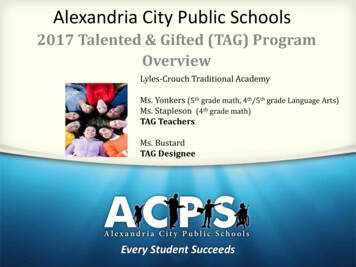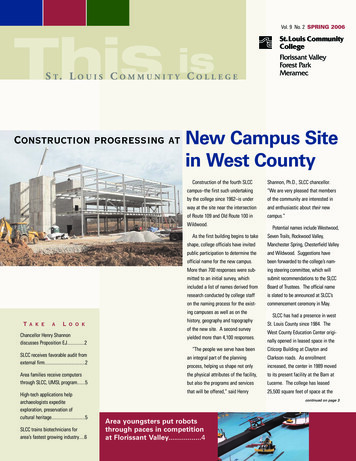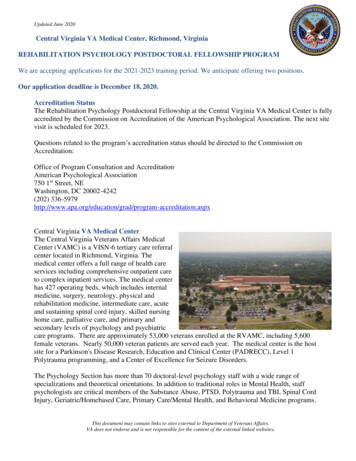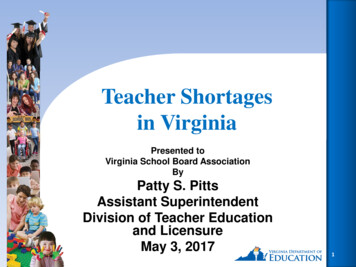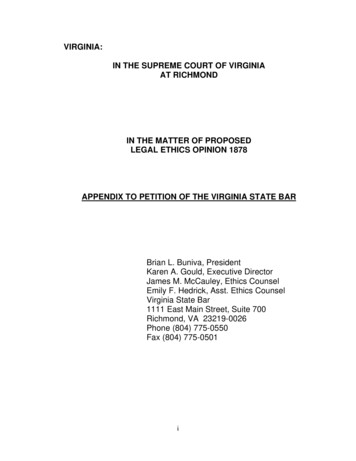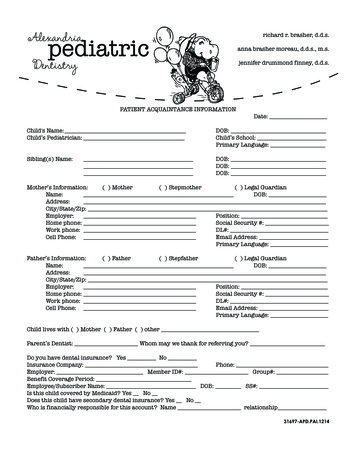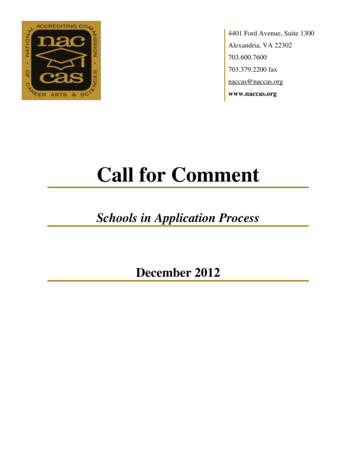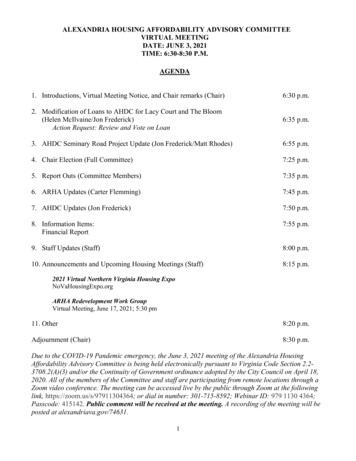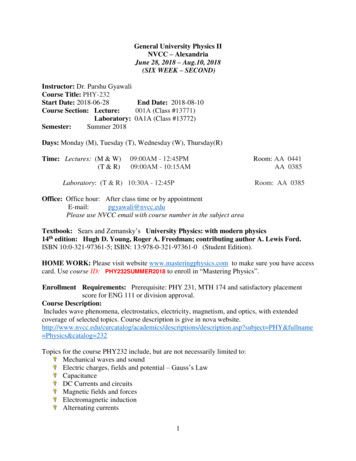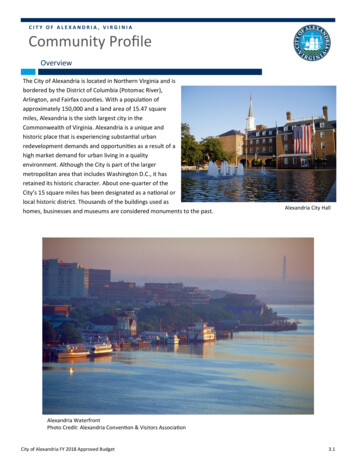
Transcription
CITY OF ALEXANDRIA, VIRGINIACommunity ProfileOverviewThe City of Alexandria is located in Northern Virginia and isbordered by the District of Columbia (Potomac River),Arlington, and Fairfax counties. With a population ofapproximately 150,000 and a land area of 15.47 squaremiles, Alexandria is the sixth largest city in theCommonwealth of Virginia. Alexandria is a unique andhistoric place that is experiencing substantial urbanredevelopment demands and opportunities as a result of ahigh market demand for urban living in a qualityenvironment. Although the City is part of the largermetropolitan area that includes Washington D.C., it hasretained its historic character. About one-quarter of theCity’s 15 square miles has been designated as a national orlocal historic district. Thousands of the buildings used ashomes, businesses and museums are considered monuments to the past.Alexandria City HallAlexandria WaterfrontPhoto Credit: Alexandria Convention & Visitors AssociationCity of Alexandria FY 2018 Approved Budget3.1
CITY OF ALEXANDRIA, VIRGINIACommunity ProfileLocationAlexandria is located in Northern Virginia, roughly 4.8 milessouth of Washington, D.C., within the original boundary stonesthat included Alexandria as part of the Nation’s Capital. It isbounded to the east by the District of Columbia and thePotomac River, to the south and west by Fairfax County, and tothe north by Arlington County. Domestic and international airservice is provided by Ronald Reagan National Airport, just fiveminutes from downtown Alexandria, and two other majorairports within 40 miles: the Washington Dulles InternationalAirport and Baltimore-Washington International Airport.Regional access is available via I-95, I-395 and I-495. TheMetrorail allows for travel into Alexandria from anywhere in theD.C. area, and Virginia Railway Express (VRE) providescommuter rail service from the Northern Virginia suburbs to Alexandria, Crystal City anddowntown Washington, D.C. Amtrak also has a stop at Alexandria’s historic UnionStation on King Street.D.C. AreaImage Credit: Visit AlexandriaThe City is an active participant in regional agencies such as the Washington Metropolitan Council of Governments, theWashington Metropolitan Area Transit Authority, the Northern Virginia Transportation Commission, the NorthernVirginia Transportation Authority, the Northern Virginia Regional Commission, and the Northern Virginia Regional ParkAuthority.The Neighborhoods of AlexandriaCity of Alexandria FY 2018 Approved BudgetImage Credit: Visit Alexandria3.2
CITY OF ALEXANDRIA, VIRGINIACommunity ProfileDemographicsThe average household size is 2.21 with a median household income of 89,134, and the average family size is 3.05with a median family income of 109,075. The population of Alexandria is very well-educated; 91.5% are high schoolgraduates or higher and 61.4% have a bachelor’s degree or higher. According to the U.S. Census Bureau’s 2015 American Community Survey, 10,004 veterans call Alexandria home.Source: U.S. Census Bureau, 2011-2015 5-Year American Community SurveyCity of Alexandria FY 2018 Approved Budget3.3
CITY OF ALEXANDRIA, VIRGINIACommunity ProfileHistoryThe City of Alexandria owns and operates seven of the premier historic sites inAlexandria, including the Black History Museum, the Alexandria ArchaeologyMuseum, Fort Ward Museum and Historic Park, Friendship Firehouse, theLyceum, the Stabler-Leadbeater Apothecary Museum, and Gadsby’s Tavern (afavorite meeting place of Marquis de Lafayette and President GeorgeWashington). Other notable historic landmarks include Robert E. Lee’s boyhoodhome; Christ Church, where famous Virginia statesmen worshipped; and theCity’s Farmers Market, at 264 years old, the nation’s oldest farmers market thathas been meeting continuously at the same site, Market Square.During fiscal year 2015, 195,485 residents and tourists visited the historic sites,museums, and events. The American Alliance of Museums has designatedAlexandria as one of eight municipal “Accredited Museum Systems” in theUnited States.GovernanceChrist ChurchPhoto Credit: Rich GrantAlexandria is an independent city with no county affiliation, and derives its governing authority from a Charter grantedby the Virginia General Assembly. Virginia is a Dillon Rule state, which means that local governments have only theauthority expressly granted to them by the Virginia Constitution or by the Virginia General Assembly in the City Charteror in general law.The City adopted the Council-Manager form of government in 1922. The governing body of the City is the City Council,which formulates policies for the administration of the City. The City Council is composed of a Mayor and six CouncilMembers elected at-large, on a partisan basis, for a three-year term (not staggered). The Mayor is chosen on aseparate ballot and presides over sessions of the Council.The Alexandria City Council operates under the Virginia Freedom of Information Act, which prohibits closed sessions ofthe Council except for specific matters regarding personnel, pending litigation and land acquisition. Accordingly, nearlyall sessions of the City Council are open to the public, where citizens actively participate in public hearing discussions.Legislative sessions of the City Council are held on Tuesday evenings twice per month except in July and August. Publichearings, which focus largely on land use and development decisions, are held on one Saturday per month whenCouncil is in session, allowing citizens an opportunity to speak on matters that concern them.Civic engagement is highly valued by residents and the City government. The City has 73 internal boards andcommissions, but also has appointees that serve on regional boards and commissions. These bodies compose a formalsystem through which citizens can advise City Council on major issues. Boards and commissions are responsible to CityCouncil, and appointments are made by Council at their regular legislative meetings.City of Alexandria FY 2018 Approved Budget3.4
CITY OF ALEXANDRIA, VIRGINIACommunity ProfileThe City Council appoints the City Manager who serves as the City’s Chief Executive Officer responsible forimplementing the policies established by the City Council. Mark B. Jinks was appointed in April 2015 to serve asAlexandria’s City Manager.The City budget provides for approximately 2,565 full-time equivalent (FTE) excluding school and DASH bus systememployees. The City of Alexandria’s Fiscal Year (FY) 2018 Approved All Funds Operating Budget is 889.6 million. TheFY2018 - FY2027 Approved Capital Improvement Program (CIP) is 2.115 billion.Council Members from Left to Right: Timothy B. Lovain, Paul C. Smedberg, Mayor Allison Silberberg (seated),John Taylor Chapman, Vice Mayor Justin M. Wilson (seated), Willie F. Bailey Sr., and Redella S. “Del” Pepper.EconomyAlexandria is home to many thriving businesses and organizations,which includes a large representation of technology companies,engineering and architecture firms, marketing, public relations andweb design firms. Alexandria has the fourth-largest concentration ofprofessional and trade associations in the country withapproximately 400 associations, behind only New York City,Washington D.C., and Chicago. These associations employ nearly11,000 people with some notable associations being the UnitedWay, American Diabetes Association and The Salvation Army. Largefederal government agencies include the United States Patent andTrademark Office (PTO), the Department of Defense WashingtonHeadquarters Service, and a new headquarters for the NationalScience Foundation IS currently under construction.November 2014Total Employment90,696Private Employment63,464Government Employment22,989Average Weekly Wages 1,322Labor Force97,241Unemployment3.6%Median Home Sales Price 494,400Source: U.S. Census Bureau, 2010-2014 5-YearAmerican Community SurveyCity of Alexandria FY 2018 Approved Budget3.5
CITY OF ALEXANDRIA, VIRGINIACommunity ProfileUnemployment Rate - U.S., Virginia, and AlexandriaU.S. Dept. of DefenseInstitute for Defense ington Metro Area TransitAuthority3.6%2.8%Oct-13Inova Health System4.1%Jun-13Alexandria City Public SchoolsApr-13City of Dec-13U.S. Dept. of CommerceSource: Virginia Employment Commission, Economic Information & Analytics, Quarterly Census of Employment and Wages (QCEW), 4th Quarter (October, November,December) 2016.Aug-1310 Largest EmployersUSAGrant Thornton LLPU.S. Dept. of AgricultureNorthern Virginia CommunityCollegeTourismOld Town AlexandriaPhoto Credit: R. Kennedy for ACVACity of Alexandria FY 2018 Approved BudgetAlexandria boasts a tourism industry that hosts over3.5 million visitors and brings in 771 million invisitor spending each year. It is the fourth mostvisited city in Virginia. This visitor spendinggenerates 25.5 million in revenue for the City vialocal tax revenue. There are twenty-eight hotelswith 4,747 rooms within the City of Alexandria. ForFY 2016, the average occupancy rate was 72.9percent. For the same time period, the averagedaily rate for hotel rooms in the City was 151. Tourism helps support Alexandria’s quality oflife and amenities for residents, including its 370restaurants, a dozen museums, cultural attractions,and more.3.6
CITY OF ALEXANDRIA, VIRGINIACommunity ProfileIn addition to its historic sites, Alexandria includesa variety of attractions. One of the metropolitanarea’s largest concentrations of international restaurants can be found in Old Town. The TorpedoFactory Art Center, located on the City’s waterfront, provides an opportunity for the public tomeet more than 200 professional artists. The City’sDel Ray/Rosemont areas offer beautiful tree-linedstreets, eclectic shops, and various annual community events.EducationDel RayPhoto Credit: Alexandria Convention & Visitors AssociationThe Alexandria City Public Schools (ACPS) is one of the most diverse school systems in the country with studentscoming from 134 different countries and speaking 113 different languages. ACPS employs 1,326 teachers and studentenrollment as of October 2016 was 15,104. The school system is comprised of 16 schools: twelve elementary schools,one pre kindergarten-8 school, two middle schools, and one high school with 2 campuses. Talented and gifted servicesare received by 11.4% of students. T.C. Williams High School offers 27 Advanced Placement (AP) courses and in 2015and 1,968 AP exams were administered. In June 2015, the high school saw 694 students graduate.Alexandria is also home to four post-secondary institution locations: George Washington University AlexandriaGraduate Education Center, Virginia Tech Washington-Alexandria Architecture Center, Northern Virginia CommunityCollege, and Strayer University Alexandria Campus.T.C. Williams High SchoolCity of Alexandria FY 2018 Approved Budget3.7
CITY OF ALEXANDRIA, VIRGINIACommunity ProfileACPS StudentsEligible for free or reduced price meals59.3%Receiving talented and gifted services11.4%Students requiring English Language Learners (ELL) services29.3%Students receiving special education services10.8%Source: ACPSThe Alexandria library system consists of one central library, theCharles E. Beatley, Jr. Central Library, and three branch libraries,the Kate Waller Barrett Branch, the Ellen Coolidge Branch andthe James M. Duncan Branch. The Kate Waller Barrett Branch isthe location of what many believe to be the first organized sit-inof the Civil Rights Movement on August 21, 1939. The sit-in wasorganized by Samuel Wilbert Tucker, who now has a local elementary school named after him, and involved five young African-American men who one by one entered the whites-only library, picked out books, and quietly began reading until theywere arrested. This event adds to the City’s rich history andspeaks to the progressive nature of its citizens.Asian,AmericanIndian,Hawaiian,5.1%ACPS StudentDemographicsMulti-racial,2.5%Black, 29.4%White, 26.9%Hispanic,36.1%Source: ACPS, as of October 2016Based on book, magazine, and newspaper sales in the City, Amazon.com namedAlexandria the Most Well-Read City in America in 2012, 2013 and 2014. The company changed it’s methodology to exclude cities below 500,000 residents in 2015.HousingOver the last decade, Alexandria has grown in population, number of households, number of housing units, and percentage of homeowners. The 2015 Population Estimates Program of the U.S. Census Bureau estimated that the Cityhas a population of 153,511 people.Alexandria Home Sales in 75106199270123791001085011386560 200K18 200K - 300K 300K - 400K 400K - 500K 500K - 600K 600K - 800K 800K - 1MCondoCity of Alexandria FY 2018 Approved BudgetSingle Family AttatchedSingle Family Detatched7315 1M Source: MRIS Statistics3.8
CITY OF ALEXANDRIA, VIRGINIACommunity ProfileThe 2015 American Community Survey estimated there to be 74,317 housing units, 90.0 percent of which are occupied. 42.5 percent of the units are owned while the remaining 57.5 percent are rented. 48.4 percent of householdsare family households while 51.6 percent are non-family households (households either containing only the householder or additional persons who are not relatives of the householder).The City’s 2015 estimated population represents a 19.7% increase from the 2000 Census, with population growing bymore than 25,000 people during this time. The number of housing units within the City rose by 15.7% from 64,251 in2000 to 74,317 in 2015. The average household size has grown from 2.04 persons in 2000 to 2.21 person in 2015.The Office of Housing coordinates and administers City housing and housing-related programs and services, andmakes recommendations to the City Manager and City Council on housing policy and potential affordable housinginvestments. They work closely with the Alexandria Redevelopment and Housing Authority (ARHA) on housing issues.Within Alexandria, both public and private owners of rental housing offer assisted housing affordable to low andmoderate income residents of the City through participation in state, local or federal programs. These units are available to income eligible households and some programs give priority or restrict admission to specific populations suchas elderly or disabled residents.Some programs and services administered by the Office of Housing include: the Affordable Homeownership UnitsSet-Aside Program, which markets a limited number of affordable resale-restricted units in new developments;Homeownership Assistance Loans, which offers no-interest, deferred payment loans for down payment and closingcost assistance toward theHouseholdspurchase of City-assistedHousing Unitsproperties for eligible applicants; and the AffordableRental Units Set-Aside Program, which sets asidesNonFamily,Owned,Rented,family,affordable rental opportuni48.4%42.5%57.5%51.6%ties within market-rate apartment properties.Source: U.S Census Bureau, 2011-2015 5-Year American Community SurveyPublic SafetyThe City of Alexandria is devoted to maintaining a safe and secure community by ensuring all community members,visitors, employees, and their property are protected from harm. Effectively achieving this goal involves collaborationbetween law enforcement and the community through public outreach and the recruitment of civilian volunteers. TheCity also collaborates with the surrounding area through the Northern Virginia Emergency Services Mutual ResponseAgreement, which allows the fire, rescue and emergency medical service agencies of one jurisdiction to assist in otherjurisdictions if necessary, creating a level of cooperation in providing emergency services to citizens of the collectivenorthern Virginia community.City of Alexandria FY 2018 Approved Budget3.9
CITY OF ALEXANDRIA, VIRGINIACommunity ProfileThe mission of the Alexandria Police Department is toprovide competent, courteous, professional and community oriented police services. Alexandria maintains amodern, highly trained police department, with a current authorized strength of 307 sworn officers and 118civilian employees. The Alexandria Police Departmenthas been internationally accredited by the Commissionon Accreditation for Law Enforcement Agencies (CALEA)since 1986 and was reaccredited in 1991, 1996, 2001,2004, 2007, 2010 and 2013. CALEA accreditation is arigorous and difficult process that, if achieved, affirmsthe professional status of law enforcement agenciesAlexandria Police Departmentworldwide.The mission of the Alexandria Fire Department is to plan forand deliver responsive and caring emergency service, mitigate emergencies and disasters, prevent the loss of life, protect property and enforce applicable construction, fire, andbuilding maintenance codes for the City residents and thegeneral public in order to maintain and enhance public safety. The Alexandria Fire Department employs 247 uniformedpersonnel and 31 civilian personnel. A network of ten stations protects the City. Among the department's specializedteams are the Northern Virginia Regional Hazardous MateriAlexandria Fire Departmentals Team, Technical Rescue, Marine Operations and the Special Operations Team. Alexandria also has a volunteer organization, the Alexandria Volunteer Fire Department(AVFD). The AVFD has served the citizens of the City for more than two hundred years, with President George Washington as one of its earliest members. AVFD members provide assistance in the areas of firefighting, emergency medical services, communications, canteen and administration.The Alexandria Sheriff's Office is responsible for the operation of the Detention Center, courthouse and courtroomsecurity, service of all court legal documents, execution of court orders, transportation of prisoners, execution ofarrest warrants, and general public safety and law enforcement. The Detention Center Bureau is responsible formanaging the security of the William G. Truesdale Adult Detention Center in Alexandria where approximately 400inmates are housed. About two-thirds of these inmates are being held for state and local charges. These inmates areindividuals committed by the courts to the Sheriff’s custody. The Detention Center operates under a managementstyle and architectural design that facilitates increased staff and inmate contact and works to reduce tension andimprove security within the correctional setting. It has been accredited by the American Correctional Association(ACA) since 1989 and the National Commission on Correctional Health Care (NCCHC) since 1991.City of Alexandria FY 2018 Approved Budget3.10
CITY OF ALEXANDRIA, VIRGINIACommunity ProfileThe Alexandria Department of Emergency Communications (DEC) ensures the effective delivery of routine and emergency calls for service to the City of Alexandria public safety departments. Its mission is to serve the public by savinglives, protecting property and providing assistance to the public. This is accomplished by receiving and dispatching 91-1 emergency and non-emergency calls for Police, Fire, and EMS in a courteous, prompt, efficient, and professionalmanner. The department’s state-of-the-art headquarters was completed in 2011 and a new computer aided dispatch(CAD) system was deployed in 2015. The department also recently implemented text-to-911 functionality in 2016.Community and Human ServicesThe Department of Community and Human Services (DCHS) provides essential safety net services that measurablyimprove or maintain the quality of life for Alexandrians. Additionally, the behavioral health programs provide compassionate and effective services that support self-determination, recovery, and resiliency for residents affected bymental illness, intellectual disabilities, and substance use
Alexandria is also home to four post-secondary institution locations: George Washington University Alexandria Graduate Education enter, Virginia Tech Washington-Alexandria Architecture enter, Northern Virginia ommunity ollege, and Strayer University Alexandria ampus. Photo redit: Alexandria onve
